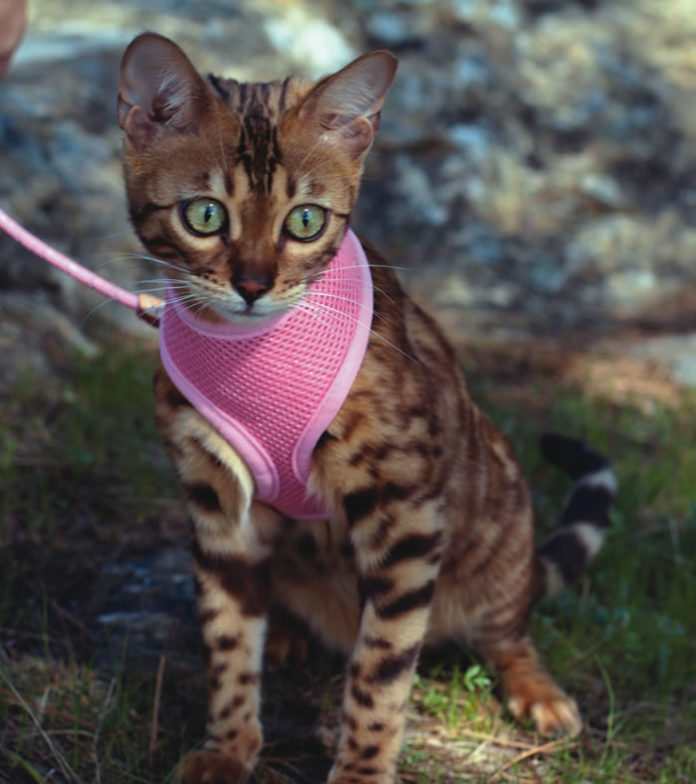Whether you want to take your cat for safe outdoor excursions or just have a little more security when transporting her in your car, a harness is the way to go. Collars are more for identification purposes, and even for firmly attached collars, cats are exceptionally good at wriggling out of them or, if they don’t, they may injure their throats in the attempt.
Types of Harness
Most cat harnesses fit into two general styles: H style or vest style.
H harnesses get their name because they look like the letter H from above when laid flat on the ground. One loop goes around the cat’s head and neck and the other around the cat’s ribcage behind the front legs, with the two loops connected by one or two straps (one that lies along the cat’s back and, in some harnesses, another which runs along the belly between the front legs). The exact way that the straps attach will vary between manufacturers.
An H-style harness should be adjustable around both primary loops to allow you to fit it to your cat. Some harnesses are also adjustable along the back and belly straps. These harnesses generally have a metal O or D ring on top to attach a leash.
Vest harnesses, also referred to as holsters or jackets, have more material and look more like the cat is wearing a little vest. There are four holes when the harness is closed: one for the head, two for the front legs (although sometimes the legs share one larger hole), and one for the body of the cat.
Styles may be adjustable at the neck and waist or may only be adjustable at the waist. Like the H harnesses, there will be a D or O ring at the top to attach a leash.
Snug Fit
The most important consideration when choosing a harness for your cat is that it fits her snugly so she can’t wiggle out. You should be able to fit one finger between the harness and your cat’s body. If you can fit two fingers comfortably, it is probably too loose. A visible gap when pressure is put on the leash is a bad sign.
Pay attention to size charts provided by the harness manufacturers. Measure your cat’s dimensions with a flexible measuring tape to get accurate measurements. If your cat is at the small end of a size range, it is often better to buy a smaller size harness to be sure you will be able to adjust it to fit her body closely. If your cat has a small head, be wary of harnesses that are not adjustable in the neck area.
Other Considerations
Consider what you will be doing with your cat in her harness. If she is just going to wear it for short walks or to hold her identification while in her carrier on car rides, you have a lot of leeway with material and style. If your cat will be going on longer outings and is likely to be active, the harness should be made of a durable material that can stand up to wear. The harness should also be comfortable for your cat. A fleece holster harness might be super cute for winter, but will get very hot and uncomfortable on a long walk in the summer.
Consider the sound that the harness’ closure makes and how your cat will react to that. Plastic buckles and Velcro are attractive to us because they are quick and easy to manipulate, but they can be loud. Desensitize her to the sound of the buckle or Velcro by making the noise during playtime or during mealtime for a while before you try putting it on.
Safety features can be a nice addition, too. Some harnesses have multiple layers of closure in case one fails, and they can have reflective strips for nighttime visibility when walking.
Harness Training
It’s all well and good to choose a nice harness that fits your cat appropriately—but how do you go about that first walk? Start by getting some special treats or a favorite toy and put the harness on your cat in the house. Properly adjust the straps immediately, then let your cat be. Most cats react as if the harness has paralyzed them, but some may jump around, trying to get out of it. Praise and reward your cat for being calm in the harness. After a few minutes, take it off. Repeat at least once a day until she is willing to move around while wearing the harness (this process may take days to weeks). At this point, you are ready to use the harness for safety purposes during a car ride or vet visit.
If you want to take your cat for walks, start by allowing your cat to take the lead—follow her where she wants to go in the house, at her speed. Over time, you can let her periodically feel pressure from the leash, but first you want her to be comfortable moving around.
Now you are ready to go outside! Your first few outdoor “walks” will probably be anticlimactic, as your cat will be taking in the sights and sounds of outdoors. Be patient, and allow her to go at her own pace. Over time, you can start exploring farther. If your cat likes treats, you can use them to reward her for walking with you or to steer her where you would like to go.




